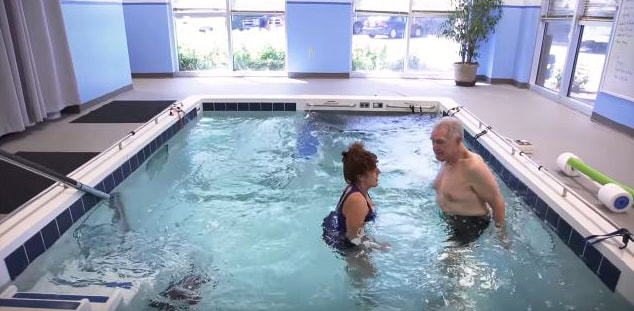
Carolina Spine and Neurosurgery (Physical Therapy) Center (CSNC) has a thriving hydrotherapy practice. The therapists at CSNC understand the beneficial properties of water and use hydrotherapy as a successful tool for patient recovery, well-being, and rehabilitation, including treating spinal cord injuries, and back rehab for elder patients. The non-weight bearing environment produces great results.
This video demonstrates how the facility uses hydrotherapy to help patients increase their general fitness:
The hydrotherapy room includes a SwimEx 1000 T warm-water (94-degree) pool with independent performance zones at depths of 4′, 5′ and 6′. The pool generates a water current with 99 speeds and can accommodate patients at all stages of recovery to safely improve mobility, balance and confidence. The pool is large enough to accommodate multiple patients in one session.
Q&A with Carolina Spine Center
What are the common diagnoses where you utilize hydrotherapy?
We work with the following:
Orthopedic: All joint replacements (once incisions heal); strains and sprains to all joints; trauma fractures to limbs requiring multiple joint limitations in rehab (once incisions heal); all sports injuries, especially with early initiation of rehab post injury; arthritic issues, to improve movement and conditioning.
Neuro/orthopedic: All spinal surgeries; basic head trauma with difficulty in coordinated movement patterns; CVA with varied levels depending on cognitive and bladder/bowel issues; Parkinson’s (to work patient outside their comfort zone); MS if we can keep the pool cool; central neurological systemic issues depending on the physician’s projection of recovery; and most spinal paralysis except high quadriplegic.
Balance issues not related to inner ear issues or Menier’s disease, but more related to CVA, physical de-conditioning, dementia, and proprioceptive loss in lower extremities.
Pediatrics for birth defects, injuries during delivery, or early trauma. This is extremely effective with children 1-8 years old.
What does a typical week look like for pool hours and scheduling?
Our pool is open 7am to 7pm, 5 days per week. Patients are scheduled for 45-minute slots and up to four may be scheduled in the same slot depending on difficulty. We schedule “high water current” patients together.
Who do you have on staff for hydrotherapy?
We have 5 therapists and 5 PTAs on staff. All PTAs work in the SwimEx hydrotherapy pool. Patients are evaluated and treatment plans proposed to the physician. If approved, the PTA will follow the plan as outlined with the therapist checking at least every 4-6 visits for changes needed.
How do you schedule therapists?
Each PTA will work one half day in the pool – am or pm. This is rotated by schedule through the 5 PTAs.
PTAs are required to be in the pool with patients. We have a waterproof computer at the side of pool for writing notes, charges, and reviewing the patient’s history and physician notes.
How many patients do you schedule in one session?
We see up to 4 patients per 45 minutes depending on the difficulty of the patient. However, we leave this up to the therapist to decide the number to schedule. Our Swimex 1000 T is large enough to accommodate multiple patients in one session.
How do you bill for hydrotherapy?
We charge in 15 minute increments, and we have a number of different systems to maximize billing. But all insurance is different and it’s important to understand parameters specific to each state, plan and region.
The fundamental properties of water support, resist and assist movement. Water creates a safe and supportive environment. It’s an ideal place to exercise, rehabilitate, and condition.
Pain leads a patient to seek physical therapy, yet it is often the exact thing that interferes with successful treatment. Water therapy helps eliminate pain and increase relief, making a patient more willing and motivated to participate in treatment and achieve successful results.
Do you use your pool in other ways?
We hold classes in the pool that are offered at specifically blocked times. These group classes are very successful and generate extra revenue. They include aqua yoga and tai chi.
Aqua yoga allows patients who are otherwise unable to practice yoga to begin a practice, especially those that suffer with weakness in their legs. They’re not even really able to do it, even with chairs.
So with the water, there’s not that fear of falling, and you move through all of the postures, and it’s a really free-flowing thing because they have the buoyancy of the water.
Many of the movements in aqua yoga classes are diagonals, things that you have to use throughout your day. The yoga allows patients to build strength in those functional patterns. Waterobics or those other types of activities don’t allow that to happen; they’re more linear in nature.
The size of the pool allows for up to six participants. It gives that group energy of people flowing together, and people love the community feeling of it too.
~ This content was developed with input from Jessica Dellaghelfa, a qualified physical therapist at CSNC.
CSNC is one of the largest private neurosurgical and spine care centers in Western North Carolina, and operates as an independent part of the Mission Hospital System.
Thinking about adding a pool to your facility?
Use the FREE ROI calculator to measure the return on investment by pool type.
See our assistance for helping you design a hydrotherapy room at your facility.
